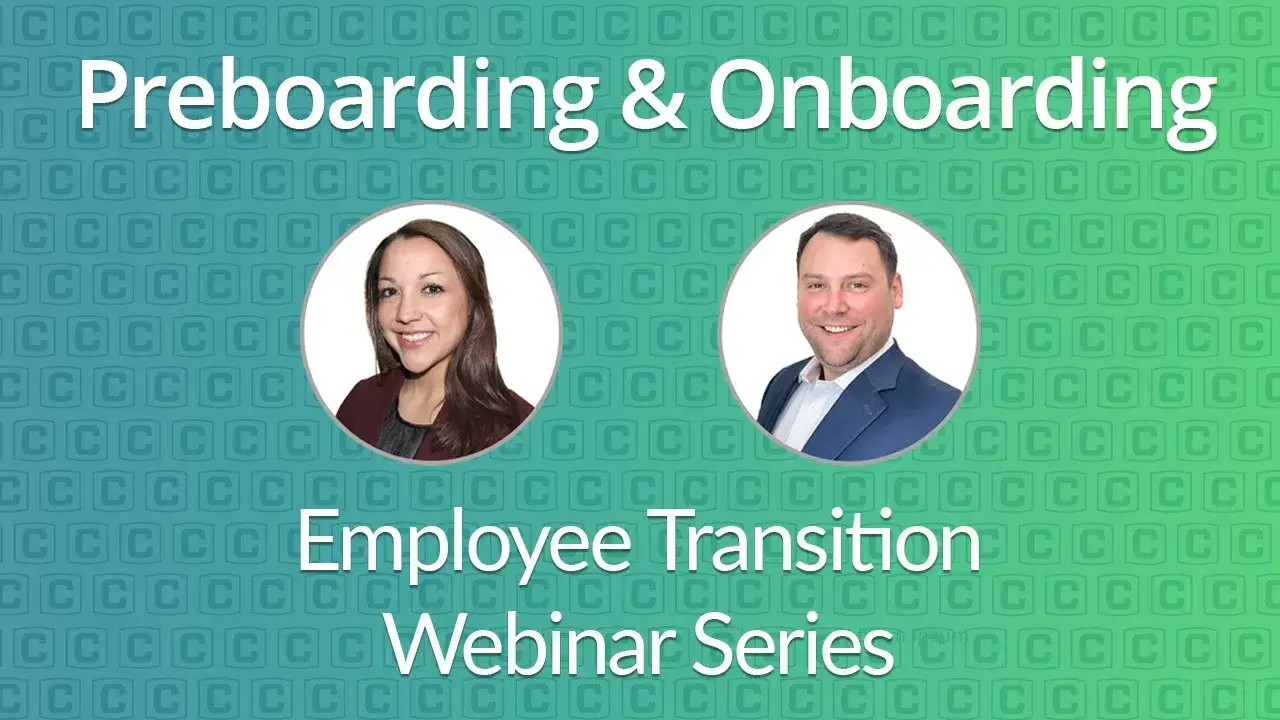Employee Transitions Webinar: Preboarding & Onboarding
Discover the possibilities to engage with new hires before Day 1 including employment documentation, preboarding activities and task management.
Video Transcription:
CRAIG: Thank you everyone for joining. This is going to be the first of many webinars that we do. They’re gonna be kind of short and sweet. We know everybody’s got a full-time job ahead of them, and we appreciate you making some time to spend with us and go through this. Michelle, would you introduce yourself? I’ll then introduce and kick things off so we can get going.
MICHELLE: Absolutely. Hi everyone! My name is Michelle Graham; I’m with Click’s Marketing Team. I get to do a lot of fun webinars and events like this – talking to HR professionals – it’s my favorite part of my job. So I’m super excited to be a part of this series, chat with Craig and answer any of your questions today.
CRAIG: Thanks, Michelle. I’m Craig Huntley. I’ve been in the human capital space – in one way or another via technology or services – for the past decade. So I’m really excited to dig into the role automation can play in the employee journey. Specifically in the employee journey, where those transitions happen from new hire to crossboarding into a new role, department or location, and ultimately exiting the organization. Obviously, I skipped a few different steps there. But from a high-level standpoint, that’s going be where we’re looking at from this series.
Today, we’re going to start from a logical first step in the employee journey. We’re going to talk about preboarding and onboarding. When someone new is joining your organization…but quickly, before we get into that, there might be some confusion around preboarding and onboarding, so I want to clear that up:
From a preboarding standpoint, we look at the key activities done prior to Day 1, setting individuals up to be engaged, have a smooth experience and be successful on Day 1.
From there, we’ll go into onboarding. For us, we talk about onboarding as Day 1. Onboarding doesn’t necessarily stop at the first week, second week or Day 30. We look at onboarding as how we make and ensure a new hire understands and has the clear expectations of what’s expected for them:
• in their job
• what success looks
• where are the tools they need to enable them to be successful
• and the resources to enable them to be successful in that role
The key difference between the two? We’ll start with preboarding; it’ll be a short video. We’ll talk through the different steps. We’ll take a little break, answer some questions and then jump into the onboarding. We’ll do some questions and answers; we’ll get through it that way.
MICHELLE: Awesome. Good deal. And I just made a comment, housekeeping: please feel free to chime in with questions within the chat. We’ll answer those after each of the demonstrations, and I will go ahead and share my screen.
CRAIG: And Michelle, while you do that, for the audience: we will share this out. We are recording this and will share this out with you afterwards, so no need to be jotting down or scrambling notes. We’ll get into you afterwards and appreciate it. All right, Michelle, we’re ready to roll.
MICHELLE: All right, cool!
CRAIG: We’re initiating a preboarding workflow. This can be initiated via integration through an ATS or manually in our system, but it sends an email and text to the new hire to begin this process and create their username and password.
We’re SOC 2 Type 2 and GDPR compliant, so no issues on the privacy. We want to make sure security is our number one focus.
This can be completed on any device. So if any device with internet and a browser, we’re going to be able to work through. That’s the candidate dashboard you can see. You can’t really skip ahead. You’ve got to run through a linear process here to make sure everything’s completed. We start with a video. Like I said earlier, we want to make sure that people are engaged, they’re excited. You’re reconfirming why they’ve joined the organization. You’re showing them things like, “Here are the values of the company.”
Continue to build that excitement and engagement! And similarly, you want to show them: here’s how to follow us. Here’s how to stay apprised of all the latest goings on with the organization and how to stay in touch with us through social.
Now there are going to be some things, some data collection pieces that we need to capture as an employer on that new employee. We’ll start with shipping address. When we ship them, their equipment, their laptops – those things – we want to make sure it’s going to the right address. We also want to capture emergency contact information…and really anything else you need as part of that employee profile. We want to start capturing this while we continue to build excitement and reconfirm their decision to join your organization (such as a swag order).
If you’re going to send somebody a welcome kit with a backpack, a mug and a t-shirt, you need to know what sizes you have that shipping address ready to go. We’ll capture all of that information, keep them excited and invested in it. But then again, getting back into some of the things we’re going to need. So you’ve got your eSignature, right? We have a proprietary eSignature which allows us to capture signatures on any of the policies that you – as an employer – may have and need your new hires to sign off. And again, they can do this on any device they need to.
MICHELLE: Awesome! Now you can see here we’re getting into the (Form) I-9, where we’re prompted to enter our address details and to complete page one of the (Form) I-9. You can see it’s fully embedded here, right in the platform. Very simple, easy and seamless, so you don’t have to go out to another system. Just validating my information to submit here. Then section two and E-Verify will be completed.
Once I start, you can see per that eSignature Craig mentioned. I’m able to apply it right here within the step. I can go back into the document and actually save a file for my records. You can see me downloading a version here, but I can also come into the Click platform – at any time – to revisit that documentation.
Here, I’m just initiating the tax information, again, collecting my data, prompting me to fill out the various fields – and another opportunity to sign off on that information and validate all looks right. Here, you can see it’ll prompt me to complete all federal and state tax withholds based on the information that I’m providing.
I personally tend to get really scared when it comes to Form I-9, W-4, E-Verify, taxes – all that stuff. But you can see it’s really straightforward, and it prompts you throughout each of the steps here. Again, acknowledging sign off, the capability to download a file for your records, just guiding you through the process, one question at a time.
CRAIG: The fun stuff of making sure that you’re actually eligible for work and can get started on Day 1.
MICHELLE: Right! Absolutely the homework, as I know you like to call it, blended in here amongst the engagement activities. When I went through the onboarding process at Click Boarding, I couldn’t believe how quickly I was able to submit my tax information!
For the Form I-9, I was convinced I did it wrong, but my hiring manager confirmed he saw it on the backend and all was good! And now here are some final more engaging activities. We’re getting a sign off on a tech and communication policy. You can upload any forms of your own for digital sign off, again, stored within the system for checking back at any point.
We have a photo upload process in this case for a badge upload, but you can collect any information documentation, within PDFs, images, you name it.
A couple additional steps here, really just setting expectations for your new hires, ensuring that they feel prepared, comfortable coming into Day 1 and they know what to expect, what to wear, where to go. You can see we have this iOS feature functionality worked into the platform, and then again, an opportunity to share any content you want in this case, just showcasing what they’re going to be experiencing week.
Finally, ending the workflow with a validation that they’ve completed their steps, and reaffirming that initial “yes” that they gave you during the recruiting process to ensure they’re ready for Day 1.
All right, I’m going to stop my screen share. Thank you, Xavier; he called out in Q&A that the chat wasn’t enabled, so I was able to turn that on; thank you for validating. Please do feel free to send chats in here for any questions on the first preboarding workflow we went through. I did get one here separately in the Q&A. I’m just pulling up around industries specifically. So Craig, we talked through some examples. Generally speaking for preboarding activities, do you see any use cases that are more appropriate for activities to include for certain industries?
CRAIG: Yes. It kind of depends on what the organization is trying to achieve. There are some manufacturing organizations we work with, and their sole goal is to move people through the process as quickly as they can. So they may actually pull out some of the experience, some of the value pieces, because they – as I love to put it, and Michelle, you’ve heard it a million times – they want to get the homework done.
I want to make sure that the new hires eligible for work have the paperwork done, and they can start tomorrow or as quickly as possible. We want to move them through that as quickly as they can. Whereas there are other use cases, where it’s how do we – when there may be a month notice between offer, accept and start date – continue to build and maintain some level of engagement and excitement along the way? Because many of us know that when you accept a job offer, you go through a hiring period and you get really excited. There’s a lot of engagement and excitement around this! You’re getting calls from your hiring manager, from department leaders, from your recruiters saying, “Hey, we’re excited to have you! Can’t wait for you to start!”
You accept the offer and all of a sudden, you don’t hear anything. We can bridge that gap to maintain excitement and engagement as they start. The answer is: it does depend on what we’re trying to solve for the organization, but there are a lot of different use cases that this can work for.
MICHELLE: Awesome. Thank you, Craig.
Another question that came in that I’d love to tackle actually, is around the types of content can we put into the system. As you saw Craig walking through some of those early steps within preboarding, we support all different types of content. Any multimedia asset that you wanna import into the system – you’re able to – whether that be PDF image files, even videos you saw early on with a Vimeo or YouTube file that you can embed directly in the platform.
We see a lot of our clients do that: introducing their executive leadership team, really reinforcing the culture, the mission, the vision. So it, it’s all possible! And as you saw: as you collect information from your candidates and share out files, those are all stored within the platform, so you can revisit and access at any time.
CRAIG: You raised something, Michelle, that I wanted to mention. The media type and the medium of the content can be configured. We can support what clients have, and a lot of times, it can be repurposed from talent acquisition on your career site.
What we didn’t show, because we didn’t jump into the backend, is we also support actions and tasks by the supporting team (HR, the recruiters, the hiring managers). We can actually provide nudges to them to reach out to those new hires as they’re in that waiting period and say, “Hey, look, Craig! We’re still really excited to have you. It looks like you completed all of your stuff!” It’s providing them the nudges they need to take the action they should be taking and typically want to take, they just don’t know how or when.
MICHELLE: Awesome. Love that. Thanks, Craig!
Another call out there, related to a couple questions we got based on industry and content. We like to talk about the three Cs for the Click platform, in that it’s all about getting the content you need, the collection of data that you need and then all in a compliant fashion. It’s delivering whatever makes sense for your new hires and your employees, based on where they’re at in their journey.
You can do that through a number of ways through our text editor, our video uploader and any content format as you saw here.
CRAIG: Yes, that’s right. It looks, Michelle, like there’s one more question here about integration. You hit the nail on the head with “What do we do with the employee personal file?”
You have a system of record, in an HRIS – a Workday, UKG, whatever the case may be – and what we do is we actually take triggers out of the ATS to build this employee profile in our system and ultimately build the integration so that we can push that employee profile into your HRIS system or system of record if you’re using something else. The goal is to enrich the data and the employee profile in a very smooth and efficient process that then lands in your system of record.
MICHELLE: Yes, great question, and thanks for catching that, Craig! I think that’s all at this point, so I’m going to go ahead and get sharing for our next workflow on the onboarding process.
CRAIG: All right. While Michelle pulls that up, just a reminder: we’re making the assumption that this is at Day 1. The individual has started, joined the organization and is now being invited into completing another few steps on a workflow to make sure they’re going to be successful in their journey. Go ahead, Michelle.
Like the last one, an email or a text is going to notify them that there’s a new workflow for them to log in and complete. Because they already have a user ID, all they have to do is log back into their system. Then you’ll see here kind of an abbreviated candidate or new hire dashboard for them to log in and complete.
First, we want to say, “Hey, congrats; you’ve completed Day 1. You did it! We’re excited to have you here, and there are going to be a couple things we want to introduce you to now, like building connections to make sure you’re successful moving forward.”
We are doing things like building out buddy programs for new hires so that they have people to ask questions to that they may be a bit afraid or embarrassed to ask their manager. We can also build things like mentorship programs in the system if it’s a little bit later in their employee transition or employer journey. We want to set them up so that they know really who’s on their team. How do I get ahold of them? Remind me who’s who. What do they do? Who am I gonna need to reach out to?
Maybe even cross functionally, it can be challenging to figure out the right person to talk to. Similarly, you look at your resources. When you join a new organization, there’s an entire tech stack that you’re trying to figure out what to do with, what is each thing’s used and what’s stored where. We want to serve that up to them, front and center, and let them go back to it anytime they need to.
MICHELLE: Awesome, and you can see here as well, the last step is calling out employee benefits. So again, setting expectations on what’s included, including links to the platform for them to go ahead and submit and really just sharing all different types of resources that communicate your culture and how they can get involved in the organization. ERGs, ensuring they have a sense of belonging, sharing appropriate contact information for different functions. We hear a lot people just don’t know how to navigate the organization, so sharing that information early and often is critical. Also, reminding them to bookmark the platform to come back at any time to have immediate access to those resources. It’s meant to be their source of truth moving forward. And you can see here at any time, they can revisit past activities they’ve completed. Right here in platform, you can see already the preboarding and onboarding activities that Jane just went through, that she can again come back to at any point.
CRAIG: Nice! Well great, thanks Michelle. I think you know, one thing we want to caveat to really quick is, we are 17 minutes into this conversation. We’ve shown you two workflows, so we’re kind of blowing through this really quickly. The intent is that we want to show you some things that we’re capable of or that you should be considering when you’re looking at a preboarding and onboarding workflow.
Obviously, what is specific to your organization may be a bit different than what we’ve shown you. And we’re happy to have some conversations around what you’re seeing in your space and how it relates to these two particular workflows.
MICHELLE: Awesome, thanks, Craig. A very relevant question on that front around the timeline for deploying an onboarding workflow: When should that go out? How long should it last? Obviously, we showed a general example. What are your thoughts?
CRAIG: Ooh, that is a tough one. I mean, the short answer is, it kind of depends. What I mean by that is it depends in the sense of what are you trying to achieve. Is the timeline how long do things last, when to deploy, it’s, what’s the goal? Is the goal engagement? Is the goal trying to impact drop off from offer except to start? Is it trying to improve productivity from Day 1 to Day 30 to Day 90?
You know, there are different levers to pull for different use cases or different results in business impact. If you’re looking at how to get somebody started as quickly as you can, minimize the work and create a more efficient process. It’s what we talked about earlier in setting up policies, for example, manufacturing. But if you’re looking at building an engagement, you want to really build out meaningful interactions from the new hire to different individuals within the team (their manager) and set the expectations. It may take longer to design that. Where they do that in their process may change, depending on your orientation and your training. That is something we have: digital transformation specialists, and their job is to really define this with our clients and say, “Hey, look: this is where it makes sense.” This is why it makes sense to do it here, based on your situation.
MICHELLE: Love it; thanks, Craig. I like that question obviously at the start. When you define the different workflows, I know you mentioned, preboarding is typically pre-Day 1, whereas onboarding, we often classify traditionally as that first 90 days.
But it does depend, and we like say internally at Click Boarding, “onboarding never does end, right?!” You’re always retaining. You should always be engaging with your employees throughout their tenure, at key milestones. I know next time around, we’ll talk about crossboarding and one-time activities….a little teaser at that, if you will!
Another question here submitted, Craig: for those who have more manual processes today (paper oriented), there are a lot of steps included here, right? Within the homework engagement, what are some quick steps that should be automated within these onboarding workflows?
CRAIG: Quick…some quick steps. Look, the answer is like anything: what requires the least amount of work and has the most value? I’m not trying to say that like dismissively. What I would look at and what I would recommend would be: (determine) what has the most impact, in terms of people that are affected in the process?
So, if you have a manual process today, there’s somebody sending out policies and forms, right to a new hire. The new hire, if they’re like me or Michelle, our printers that we have don’t work. They’re out of ink or we don’t have one. We have to run down to Kinkos, get them printed out, sign them, read them and etc., scan them back in at Kinkos and then email them.
And in the meantime, there’s probably somebody from the new organization that we’re joining that’s emailing us going, “Hey Craig, can you please send these things? We keep reminding you, and I’m tired of tracking you down.” I have to tell them I didn’t know the hours of Kinkos, and that’s embarrassing.
But the point is we want to minimize the work required and improve the experience of the people that support these activities. Your HR team is tracking down all these policies in a manual environment but also the new hires. You know, if you can sign all of your paperwork, complete all of it on your phone, a tablet or a computer, versus running around trying to get things printed, that’s where I’d start.
And then from there, you’ve got your building blocks, you’ve got the blocking and tackling. You can then start building on the experience and the engagement, leveraging what you may already have from a talent acquisition and a career site standpoint.
MICHELLE: Awesome. Thanks, Craig. And we had another question come in here. “Is there audit ability on the backend to ensure tasks are being completed?” Very relevant.
CRAIG: Yes, of course. Yes, there is. We’ve kind of dubbed this, essentially a Domino’s tracker. For those that are familiar with ordering Domino’s or who have seen the commercial, we’ve got stages of the process, and it tells you where they’re at in the process.
We have a very similar kind of spider web of activities that are completed, and it’ll tell you what’s been completed. You can actually click into it to see the information there, the signed document, the uploaded picture, the size t-shirt they need for their swag order, and you can see what’s left to be completed.
Because we’re also using due dates based on start dates, we can see it’ll automatically remind the new hires that they need to go in via text and email, that they need to go back in and complete these steps for their new hire paperwork.
So again, eliminating the HR person looking and thumbing through the file to go, “OK, I’ve got this. I don’t have that. I need to send an email and make sure that they send that back.” We want to eliminate that as much as we can. We do have the ability to check and see what’s in progress and send out automatic reminders to those individuals.
MICHELLE: Thanks, Craig. Yes, I love that it really helps reduce a lot of that noise and prevent babysitting. Call it like it is! HR is often chasing around team members trying to collect information and hiring manager.
I’ve found as I brought new team members into Click Boarding, it’s really awesome to get the alerts or nudges real-time to understand where new hires are at in their journey. The system can remind them if they’re behind schedule. I can even step in to troubleshoot if needed, because I have that alert right in front of me rather than going and digging to look for it. It’s meant to build accountability into the process, because every team member, every stakeholder involved in onboarding typically has really good intent, but the follow through is difficult. So the technology here just enables them with the information readily available.
I think that calls all questions for us here. Any final thoughts, Craig, before we close out? I know we got through a lot here in the last 24 minutes but want to be mindful of everyone’s time.
CRAIG: I guess I’ll leave with this: I’ve been around the human capital and technical services for a long time, and the conversation tends to: what can I automate, and automation is king. Can automate this and that? I think there are a lot of times where we’re trying to over automate.
The real purpose of this and why we’re looking at this is that we want to give people back time in their day to do the things that can’t be automated. If we can automate some of the more transactional activities and in a new hire process, what time does that give back to your team – in HR and talent acquisition and your hiring managers – and what can they do at that time?
What are the high-value tasks that they’re pushing off by sending out reminder emails and doing an audit? What can we be doing instead of these transactional activities that provide your employees more meaningful interactions? That provide your business larger impact in terms of productivity, retention and things like that?
We’re not trying to over automate everything. What we’re trying to do is automate the things that give your team the time back in their day and the tools to provide more value to the organization and more impactful activities.
MICHELLE: Awesome; couldn’t have said it better! Thanks, Craig.
Again, we’re just coming up on the end here, so I want to thank everyone for joining us. Like Craig mentioned, we will send out a copy of this recording. Please do feel free to share with your colleagues and team members. We’d love to have more of you on with us, and we appreciate you taking time out of your day. We know it’s hard to do things and separate yourself for a little bit, so we appreciate it.
Please do feel free to join us next time. Like Craig said, this is a series. In two weeks from today, we’re going to do another one on crossboarding activities and one-time HR events, and we’d love to have you there.







